Discovery Sport Too Cool for Iceland
By John Gilbert
REYKJAVIK, Iceland
Often when you take a trip, the proper cliche is “getting there is half the fun.”
Not this time. When Land Rover invited auto journalists for a first test-drive of its new Discovery Sport, it chose Iceland. Maybe I was the only person in snowy and icy Minnesota to be excited about making a January trip to snowy and icy Iceland, but being there was ALL the fun. Only a weather-delayed flight proved disappointing, compressing my group’s time from three days to two.
To be the trip’s prime attraction, the Discovery had to compete with amazing visual sights that included primitive roadways, a lack of traffic, towns, and alternative routes. There was not a lot of snow, and, by the way, not a single day from January through March passed when Reykjavik didn’t have warmer temperatures than Duluth, Minnesota.
After finally arriving in Iceland’s main city, where about three-fourths of the country’s less-than half-million people reside, we checked in at the Design Hotel 101 in downtown Reykjavik, but didn’t have time to unpack. We were fitted with “66-degreeNorth” down jackets, gloves, hats, and other severe-weather-beating apparel, just in case, and then we were off to the product presentation. Promptly, we hit the road for the designated circuit of several hundred miles on mostly narrow, 2- lane roads that passed by mountains, volcanos, hot-spring pools, and terrain that includes tectonic plates, which shift every year and are gradually splitting Iceland in a equally toward North America on the west and Scandinavia on the east.
At one point, we seemed to be bunched up, caravan-style, at an outpost. A Land Rover guide explained the fissure between tectonic plates that are causing gradual continental split dividing Iceland. He added that the roadway ahead was clear, and with studded tires mounted, we should try to pick up the pace to 60 miles per hour or so. Easily done.
The ideal way to tour the rugged countryside proved to be the Discovery Sport. It is the entry-level compact SUV from Land Rover, a British company that builds larger and more luxurious engineering marvels under the names Range Rover, Evoque, Defender, LR-4, and previously the LR-2, which will be supplanted by the Discovery.
The company, formerly owned by Ford, is now owned along with Jaguar by Tata Motors in India. But it’s never lost its identity, nor its pride in building the most capable off-road vehicles without ever compromising on comfort, safety and luxury.With the top Range Rovers listing for nearly $150,000, it is impressive to see how the company combines all those standards into a Land Rover Discovery that starts out at $38,000. Regardless of price or perceived stature, the Discovery Sport over-achieved in every way, no matter how desolate the roadways.
At another outpost, we were ordered to turn left, down a bank toward the Hvita River, rushing along between the rare connection of two parallel roads. We were crossing, hood-deep in rushing, chilly water, to prove the Discovery Sport’s 24-inch wading capability. No problem.
As vehicle program director for Discovery 4, Paul Cleaver has been with the car since the first sketches and clay models. “I’ve taken it from the early concept stage with designers, to production,” said Cleaver. “It’s absolutely like giving birth. The proudest moment of my life was the birth of my son, Archie, and the second proudest is the birth of this Discovery Sport.”
Tata is based in India, but it has left Land Rover, and cousin Jaguar, with well-financed backing to stay in England. “This is the entry level Land Rover product. This is a lot smaller than the LR-4, but the space in the interior shows the team has done a fantastic job of versatility,” said Cleaver. “The third row and the sliding second row are class-leading. I think we’re the best now at making the exterior compact but having a large interior space.”
The class-leading interior volume includes a second row that slides 6.3 inches, and reclines. There is 27.8 cubic feet of storage behind the third seat, or 31.75 cubic feet with the third seat folded, or up to 60 cubic feet with both seats folded.
The Discovery Sport has permanent all-wheel drive, and, Cleaver explained, Land Rover has engineered a new rear suspension system to strike a balance between on-road dynamics and off-road capability, yet still provide the driver with all sorts of comfort. Designed from scratch, the rear suspension has a unique integral link and an aluminium lower control arm.
For a powertrain, Land Rover borrowed from its more-luxurious brother, the Evoque, and uses the same 2.0-liter turbocharged 4-cylinder engine which came from Ford, Land Rover’s previous owner. It develops 240 horsepower, and its 9-speed ZF automatic transmission is at its best swapping gears for optimum ratios mid-range, with top gear designed for highway cruising, and first gear aimed at serious off-roading. The Discovery Sport will hit a 125-mph top speed, and still deliver 28 miles per gallon highway, with an EPA estimated 23 mpg combined city-highway.
Structurally, Discovery Sport also borrowed from the Range Rover Evoque, using a steel monococque body, with aluminum — “aluminium” to the Brits — in selected areas, such as the bonnet (hood), roof, and tailgate, and magnesium cross beams are used for strength and reduced weight, compared to the high-strength and ultra-high-strength steel of the rest of the structure.
Before I ever laid eyes on the Discovery Sport, the trip was certainly an adventure. It was going to be long, flying from Duluth, MN., to Minneapolis, then to Toronto, from where I would board an IcelandAir flight to Reykjavik. It got suddenly longer when I was contacted by Land Rover officials who said the trip would be delayed because a winter storm would prevent any aircraft from landing in Iceland for 24 hours. Everybody else in my group was connecting through Boston, so I was alone camping out in the Toronto Airport Sheraton’s fine accommodations, because the one-flight-per-day trip to Iceland wouldn’t depart until 7:30 p.m. the following day. I envisioned a snowstorm that only a Minnesotan might appreciate burying Iceland, but it turned out there was very little snow — just winds blowing at up to 100 miles per hour from west to east across Iceland, eliminating any possibility of seeing across the country, much less landing from the sky.
Once on the road, I was surprised we saw no wildlife, and I asked a resident if there was any. “Horses,” he said. I told him back in Minnesota, we didn’t refer to fenced-in horses as wildlife. “And some foxes and mink,” he added. We never saw any, but, whatever, the lack of traffic and wildlife was offset by breathtaking scenery, everywhere we looked.
We paused at another road-side stop, where another Land Rover guide in another aging but beautiful Range Rover Defender awaited us. Ahead, off to the left in the fading sunlight, was a magnificent white mountain peak. “That’s the Baula Volcano,” he said. “It’s so well-known that the road you’re on is called Volcano Road.”
The models we test-drove were all loaded up with features, and were priced at about $45,000. The HSE Luxury Pack includes expansive sunroofs, an 8-inch nav and information screen that rivals an iPad in size, and with surprisingly adequate three-row seating inside that compact silhouette. Stadium seating means those in the second row sit an inch or so higher than row 1, and row 3 sits higher than row 2, aiding visibility for the occupants. Flip a switch and the second row folds down electronically. There are seven USB charging sites, taking care of everyone, even if you squeeze in seven occupants.
The Discovery Sport proved more than worthy, even when I gave it that special test beyond anything Land Rover folks might have imagined. The experience gave me a better idea than even Paul Cleaver had about how stable and responsive their new vehicle is. Sophisticated electronic aids work seamlessly. The HDC driving command computer responds to a pitch-rate sensor that detects corners and reduces speed without driver intervention. The terrain response system has push-button control of four modes: general driving, mud and ruts, sand, and snow and ice, and also affects the electric power-assisted steering. The mode shown on the screen notes DFC or HDC, where the powertrain is directing its torque, and which direction the front wheels are pointed, which is vital in off-road driving.
Late in the drive, I was approaching a small rise on Hwy. 1, Volcano Road, going about 60 on a clear road, and I hit the rear window washer and wiper. I glanced in the rear-view mirror for a millisecond to see that the window was cleaned sufficiently, and looked back ahead. To my horror, the unmarked road atop the small rise looked a lot like a skating rink. Solid glare ice. Worse, there was an unmarked “T” intersection 100 feet ahead. I yelled to my partner: “Hang on! This isn’t going to be pretty!” Without question, I was going too fast to make the 90-degree turn, studded tires or not, but I stabbed the brake pedal hard, and edged left hoping the slightly dished left edge might help convince a tire to make the turn. It didn’t. Our Discovery Sport skidded sideways, crossed the intersection, and went almost gently right off the road. My instincts from scaling Duluth’s cliffside avenues took over, and as we settled off the intended road, I hit the gas. The responsive turbo churned straight ahead, until I could pull the steering wheel left. Amazingly, we simply climbed back up onto the road — and kept going! No damage, no break in schedule.
“Going from the clay modeling in the studio, with all the different concepts and schemes, and taking it through to production, has really been exciting,” said Cleaver, the product manager who has been with Land Rover for 20 years. “Now, to see the cars rolling around Iceland, it makes the hair stand on the back of my neck.”
Imagine if he had been riding with us!


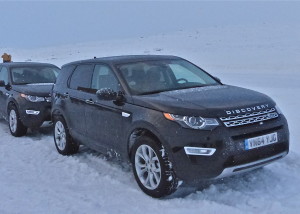
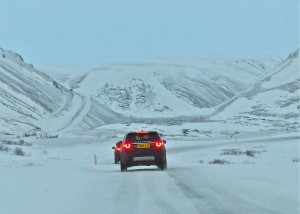
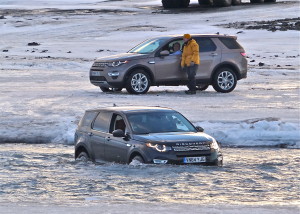
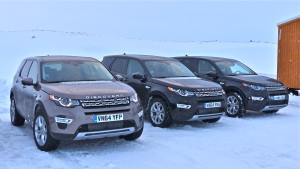
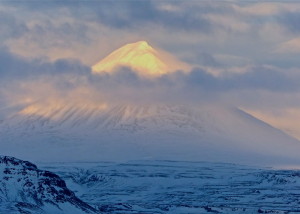
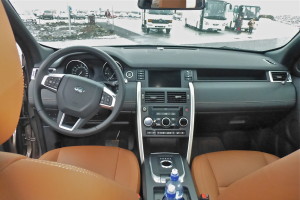
 John Gilbert is a lifetime Minnesotan and career journalist, specializing in cars and sports during and since spending 30 years at the Minneapolis Tribune, now the Star Tribune. More recently, he has continued translating the high-tech world of autos and sharing his passionate insights as a freelance writer/photographer/broadcaster. A member of the prestigious North American Car and Truck of the Year jury since 1993. John can be heard Monday-Friday from 9-11am on 610 KDAL(www.kdal610.com) on the "John Gilbert Show," and writes a column in the Duluth Reader.
John Gilbert is a lifetime Minnesotan and career journalist, specializing in cars and sports during and since spending 30 years at the Minneapolis Tribune, now the Star Tribune. More recently, he has continued translating the high-tech world of autos and sharing his passionate insights as a freelance writer/photographer/broadcaster. A member of the prestigious North American Car and Truck of the Year jury since 1993. John can be heard Monday-Friday from 9-11am on 610 KDAL(www.kdal610.com) on the "John Gilbert Show," and writes a column in the Duluth Reader.